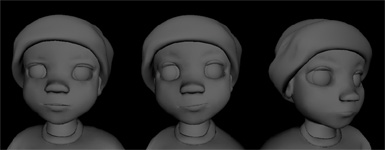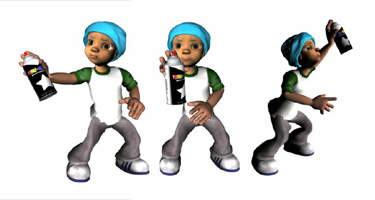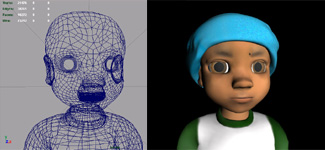|
The Animation Process
The production of an animated short takes quite a bit of preparation and planning
(especially when operating within the confines of a seven-week project cycle). Below is an overview of
the process by which our group was able to create "I Wuz Here":
- Script - Artistic achievements and technical marvels while important to a film, must
still rely on the foundation of good story. The original script for our digitally animated film was written by the ETC's own
Matt Udvari. With the initial concept in-hand, the group next proceeded to refine and polish the pre-existing story. During
this time, feedback and suggestions were elicited from a variety of sources including the faculty, staff, and students of the
Entertainment Technology Center as well as outside sources such as Ron Tippe (the producer of Shrek). The resulting story elements
were generated by the team and were an invaluable tool entering the project.
Please click here for a rough treatment of our script.
- Concepts - During this phase members of the group sketched concepts for the various
characters and environments that might possibly exist in our world. Special attention was paid to the young boy, Carver,
who was to become our main character. A gallery of concept art may be found by clicking on the image below.

- Storyboards - With our story further locked down, the group was able to make hand-drawn storyboard
that would later be useful in the setting up camera shots and animations. These images look very similar to a comic
strip. Please click on the samples below to see the entire storyboard.

- Design -After review of the early concepts, decisions on the look of the character were made.
These choices were later enhanced through use of schematic and detailed drawings. In addition, color sheets were produced
to identify color choices of the wardrobe and skin tones.

- Animatic - Once the storyboards were finalized, the group created an animatic. An animatic is a
development tool in which the story is roughly filmed so that style, pace, and look can be analyzed. During
the filming of the animatic, the group took steps to quickly show the basic structure of the story utilizing
the available tools. Although we chose to film the animatic using live-action, a storyboard and rough 3D animatic
were also created. While editing the early animatic Jazz Beitler proved to be a great help in planning shots and making cuts.
To view the rough animatic (compressed with the DivX Codec), click here.
If you do not have the DivX Codec please click here to download it.
- Music - Because the animated short contains no dialogue,
the need for a quality soundtrack and effective sound effects are crucial to convey the mood
and tell the story in "I Wuz Here". During the initial planning phases of the project,
the group realized that a very effective soundtrack would most likely begin the story with
a low urban bass beat that would transform during the course of the score and eventually
wind up as a more fantastical, melodic creation. To realize this sound, the team enlisted the
aid of Yusei Horiuchi who utilized his musical talents in the making of an amazing piece of music.
At his disposal, Yusei had the early animatic as well as concept art and the input of the team.
Please click here to hear the original soundtrack
- Modeling - This is the first use of any
computer animation tools. Modeling is simply the process of
building three dimensional objects from two dimensional drawings
inside the computer. For this process the group used Maya and 3D Studio Max 4.2.
Please click on the image below to see a gallery of our early models.

- Layout - In parallel with the modeling of the characters, the environment
was also being designed. Critical tasks in creating the environment included creating an atmosphere,
scaling the world to the characters, and positioning objects of importance that would be necessary to the
unfolding of the story. Early diagrams, building models, and miscellaneous items are featured in the
Environment Gallery.

- Articulation - With the characters fully modeled and textured they now needed to be
given the ability to move. Motion capture, Inverse Kinematics (IK), and keyframing were all employed to move the character's.
For motion capture the group enlisted the aid of Morgan, the 4-year old nephew of the ETC's own Janeen LaForce.

- Texturing - Once the modeling phase was
completed, the group assigned textures to the model's surfaces. For the application of textures
Maya, Deep Paint 3D, and 3D Studio Max were used. In addition to flat textures bump maps were also used to
provide layers of depth and detail. Some textured models may be viewed in the Textured Models Gallery by clicking
on the image below.

- Animation - During this phase the characters were brought to life. Facial
expresssions and movements were carefully laid out for each character in every scene. The resulting
animations were tweaked many times to create the right feel and look. Assistance on the use of expression
to convey a particular message was provided to the group by Brenda Harger.
- Lighting - In order to create the proper mood and detail in the characters, effective lighting
within the 3-D environment was required. Assistance in the lighting of scenes was provided by Dan Schoedel.
Proper lighting was crucial to the animation process and occured directly before the rendering phase.
- Rendering - The process of the computer
calculating all of the attributes assigned by the animator to a
particular frame is known as rendering. The rendering time for the animated short
was roughly as long as the processes before. For final render scenes were transferred from Maya to
Renderman were shaders were added and rendering could begin. Steve Audia was a major help to the group in
setting up computers and acquiring the proper licenses.

After rendering, the scenes will be assembled in Adobe Premiere and imported into AfterEffects for post-production.
Please click here to view some of our completed renderings.
Also, click here to see our current process film.
|